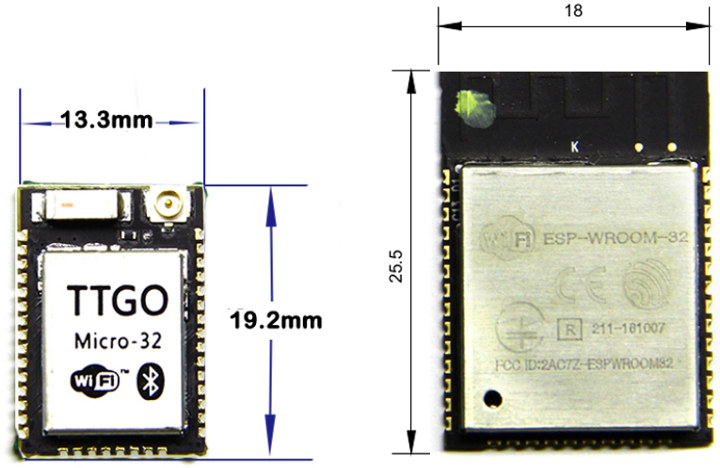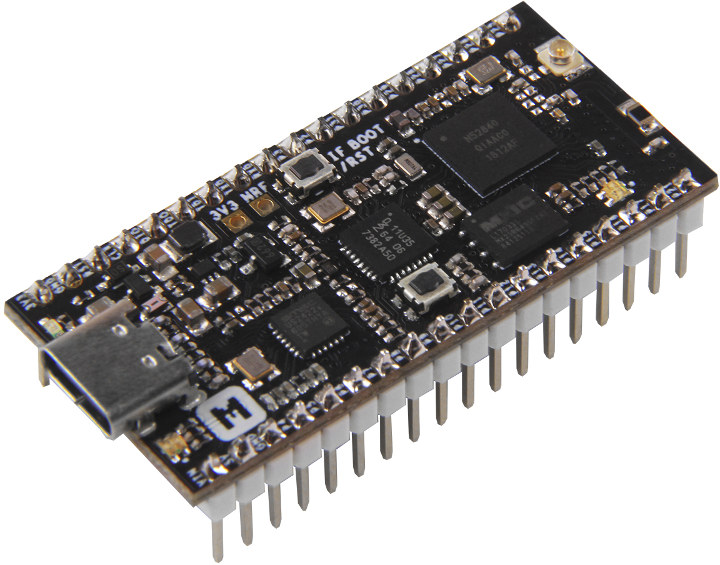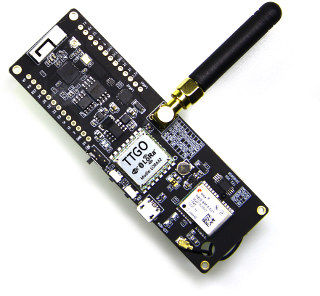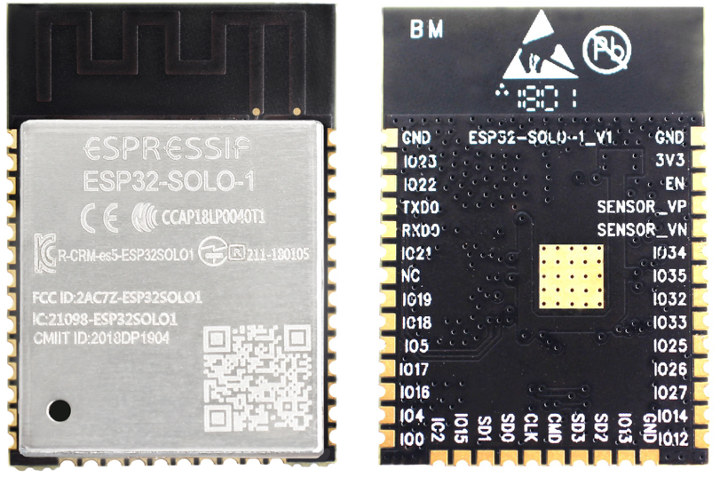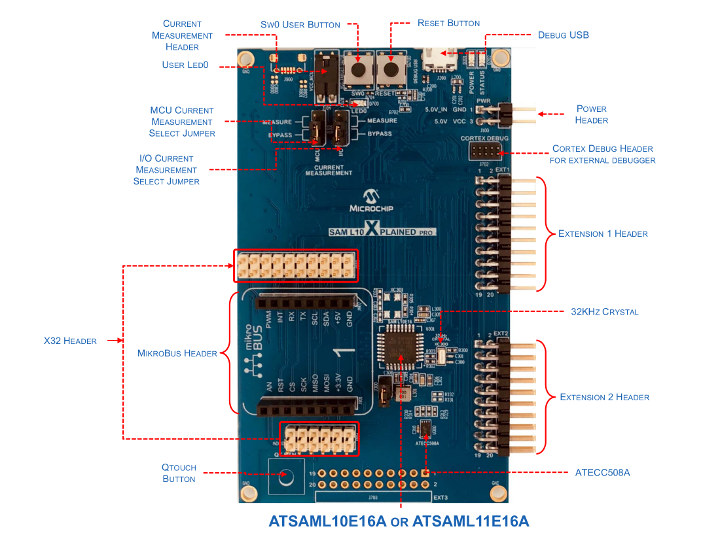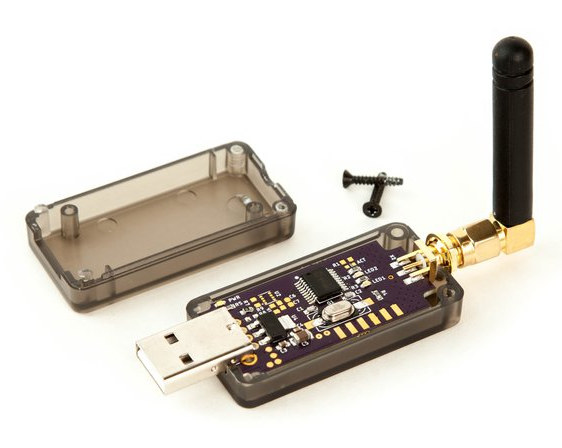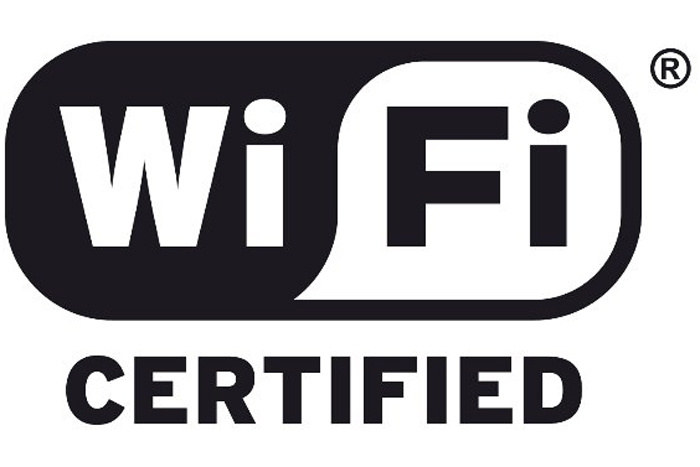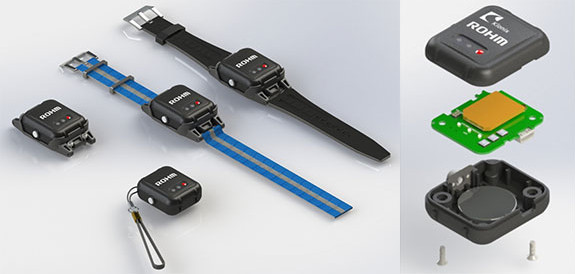Unveiled almost a year ago, ESP32-PICO-D4 SiP (System-in-Package) combines ESP32 wireless processor, 4MB SPI Flash, a crystal oscillator, as well as some passive components, and allows more compact or thinner designs such as found in ESP32-PICO- Kit v4 development board. However, so far I had not seen any ESP32-PICO-D4 module, but TTGO Micro-32 fills the void as a compact module based on the SiP. TTGO Micro-32 module specifications: SiP – Espressif Systems ESP32-PICO-D4 based on ESP32 dual core processor + 4MB SPI flash Connectivity – Bluetooth 4.2 LE and 802.11 b/g/n WiFi up to 150 Mbps with chip antenna and u.FL (IPEX) connector Expansion – Castellated holes with GPIO, ADC, DAC, VP/VN, Touch, UART, I2C, and power signals Supply Voltage – 3.3V Dimensions – 19.2 x 13.3 mm (45% smaller than ESP32-WROOM-32) There’s no specific software for the module, since it should be software compatible with ESP-WROOM-32 (now called ESP32-WROOM-32). […]
Makerdiary nRF52840 Micro Development Kit Works with OpenThread, Arm Mbed OS, Zephyr OS, Mynewt, etc…
If you want to play around with Bluetooth 5, Nordic nRF52840 is probably one of the best option, and among the development board, $9/$12 Particle Xenon is hard to beat when it comes to value. But if you need a bit more storage, I/Os and features, Makerdiary nRF52840 micro development kit looks like a good candidate to evaluate, especially it supports plenty of frameworks / operating systems such as Arm Mbed OS, Zephyr Project, OpenThread, Mynewt, and others. It’s also the first MCU class board I’ve seen with a USB type C port, although I’m not sure it brings any benefits to this type of hardware. Makerdiary nRF52840 micro development kit (nRF52840-MDK) hardware specifications: SoC – Nordic nRF52840 Arm Cortex-M4F WiSoC with 1 MB FLASH and 256 kB RAM, Arm TrustZone Cryptocell 310 security subsystem External Storage – 64-Mbit QSPI flash Wireless Connectivity (on-chip) Bluetooth 5, Bluetooth Mesh Thread, IEEE […]
Design ESP32 LoRa GPS Tracker Applications with TTGO T-Beam Board
TTGO introduced a small ESP32 LoRa board with OLED display last year that is still selling for around $14 shipped. But the company is now back with a similar board called TTGO T-Beam that does without the display, but adds GPS support, and a 18650 battery holder, so it should be ideally suited for all sorts of LoRa GPS tracking applications. TTGO T-Beam board specifications: SoC – Espressif ESP32 dual core Xtensa LX6 processor with WiFi and Bluetooth Memory – PSRAM Storage – 4MB SPI flash Connectivity 802.11 b/g/n WiFi up to 150 Mbps + Bluetooth 4.2 Classic and LE with “3D antenna” soldered on PCB LoRa 433, 868, and 915 MHz versions with SMA antenna Transmit current – 120 mA @ +20dBm; 90 mA @ +17dBm; 29mA @ +13dBm Receive sensitivity -139dBm with LoRa & 62.5Khz & SF=12 & 146bps -136dBm with LoRa & 125Khz & SF=12 & 293bps […]
ESP32-SOLO-1 is a Single Core ESP32 WiFi and Bluetooth Module
Espressif ESP32 is popular dual core processor with built-in WiFi and Bluetooth connectivity, except as we’ve seen last year, the company also developed a single core version with ESP32-S0WD chip, whose price is only slightly more expensive than ESP8266. But so far, I had not seen many hardware platforms announced with the single core version, with the exception of Particle Argon board. But I believe we should soon see more ESP32-S0WD boards brought to market, since Espressif Systems has now announced ESP32-SOLO-1 single core module. ESP32-SOLO-1 wireless module specifications: SoC – Espressif ESP32-S0WD single core Tensilica Xtensa LX6 processor @ up to 160 MHz with 448 KB ROM, 520KB on-chip SRAM, and 16KB SRAM in RTC Storage – 4MB SPI flash Connectivity 2.4 GHz 802.11 b/g/n WiFi up to 150 Mbps Bluetooth 4.2 LE + EDR I/Os – SD card, UART, SPI, SDIO, I2C, LED PWM, motor PWM, I2S, IR, […]
Microchip Unveils SAM L10 & SAM L11 Arm Cortex-M23 MCU Families with Arm TrustZone for Armv8-M
Microchip has recently announced new SAM L10 and SAM L11 Arm Cortex-M23 MCU families, with the SAM L11 family featuring Arm TrustZone for Armv8-M that provides hardware isolation between certified libraries, IP and application code. SAM L10 & SAM L11 MCU Families Key features: Arm Cortex M23 Core @ 32 MHz Up to 64 KB Flash and 16 KB SRAM picoPower Technology less than 25 μA/MHz in active mode less than 100 nA in sleep mode Fast wakeup time: 1.5 μS Flexible power saving features Enhanced Peripheral Touch Controller (PTC) with improved water tolerance, noise immunity and responsiveness Security (for SAM L11 only) Chip-level tamper resistance Arm TrustZone technology Secure boot Secure bootloader Crypto accelerators Secure key storage Op amp ADC and DAC Package – VQFN32, TQFP32, WLCSP32, VQFN24, SSOP24 Microchip SAM L10 MCU achieved a ULPMark score of 405, or over 200 percent better performance compared to the nearest […]
LoStik USB Dongle Adds LoRa Connectivity to any Computer or Linux Board (Crowdfunding)
We’ve covered plenty of hardware with LoRa radio from gateways, to Arduino shields, tracker boards, and mini PCIe cards, but after reading an article on Time4EE this morning, I realized we never wrote about any LoRa USB stick. LoStik – previoulsy LoRa Stick – is an open source hardware USB dongle based on Microchip RN2903 / RN2483 LoRa module, and offered on CrowdSupply for $39. LoStik specifications: USB – USB 2.0 port LoRa Connectivity Microchip RN2903 – 915 MHz for US, Canada, South America and Australia Microchip RN2483 – 868 Mhz for Europe Receiver Sensitivity – down to -146 dBm TX Power – adjustable up to +18.5 dBm Range – up to 15 km coverage in suburban and up to 5 km coverage in urban areas Misc – 2x user LEDs Power Consumption – 140 ma typical TX, 20 ma idle (with power LED) Dimensions – 80 mm x 25 […]
WPA3 WiFi Security Formally Introduced, WiFi Easy Connect Allows Easier Setup of Headless Devices
While I still see some open WiFi access points from time to time in the wild, most people are using WPA2 authentication to connect securely to their own WiFi router, or public ones instead of WEP that has been found to be insecure many years ago. WPA2 is not quite secure as it once was, as last year WPA2-PSK was cracked. It’s not that bad, as it may still take several days with a strong password requiring a large password file for the hack to work. Still a new revision was needed, and the WiFi alliance has just introduced Wi-Fi WPA3 security. Just like with WPA2, there are personal and enterprise modes for WPA3 WPA3-Personal WPA2-Personal Pre-shared Key (PSK) is replaced with Simultaneous Authentication of Equals (SAE), which is said to be resistant to offline dictionary attacks where an adversary tries possible passwords without further network interaction. WPA3-Personal/SAE enables: Natural […]
RoKi Sensor Node Bluetooth 5 Devkit is Equipped with Multiple Sensors
ROHM and Kionix have just introduced the RoKi Sensor Node, part of the new RoKi IoT Platform. The sensor node is based on Nordic Semiconductor’s nRF52840 Bluetooth 5 LE System-on-Chip (SoC), and integrates multiple sensors from Kionix and ROHM. RoKi Sensor Node specifications: MCU – Nordic Semi nRF52840 Bluetooth 5 Arm Cortex M4F processor @ 64 Mhz with 1 MB flash, 256kB RAM Sensors Built-in 3-axis accelerometer Combination 3-axis accelerometer + 3-axis magnetometer Combination 3-axis accelerometer + 3-axis gyroscope 3-axis magnetometer Barometer Available with expansion connectors Optical heart rate sensor Ambient light sensor RGB color sensor Magnetic hall effect sensor etc Misc – Programmable RGB LED Power Supply – Rechargeable Li-Polymer battery, replaceable coin cell batteries, or via Micro USB. Battery life – Active time is about 8 hours of typical usage, and an estimated standby time of 200 hours. Dimensions – 42x67x22mm The sensor node comes with a mounting […]


